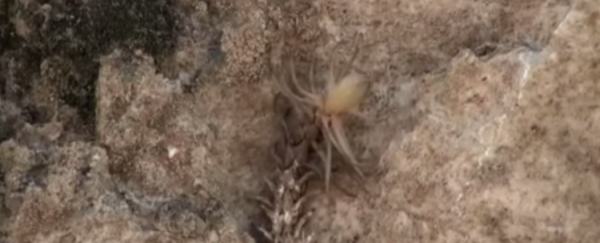
First off, we can't decide if that narrator needs to be fired or given a knighthood, because wowow. But if you're going to be overly dramatic about something, it might as well be the spider-tailed horned viper (Pseudocerastes urarachnoides), an endemic - and truly bizarre - species of western Iran.
First discovered back in 1968, the scientists who stumbled on the first specimen assumed that spider-like growth on its tail was actually a spider, because it happened to look exactly like the very large camel spider, which was native to the same region. A closer analysis revealed that the 'spider' on the end of the snake's tail was actually strange boney appendage, but it was generally accepted that it was a freakish mutation, and not how the snake was 'supposed' to look.
Many years later, closer analysis of a live specimen - just one, because these snakes are notoriously difficult to find - revealed this odd tail appendage was not a mutation, and was in fact consistent across all the literature relating to this particular animal. So in 2006, zoologist Hamid Bostanchi from the University of the Pacific in the US declared it a new species, spider-tailed appendage and all.
And boy, does this reptile sure know how to use what evolution has given it. A few years after its classification was complete, biologist Behzad Fathinia from Razi University in Iran decided to test a theory put forward by Bostanchi that the tail existed to lure in prey. Fathinia managed to catch a live specimen of his own, put it in an enclosure with a rather unfortunate chick, and watch what happened. The tail started moving, and flickering, just like a spider. "It was very attractive and looked exactly like a spider moving rapidly," they reported in 2009. "After approximately half an hour, the chick went toward the tail and pecked the knob-like structure. The viper pulled the tail structure toward itself, struck and bit the chick in less than 0.5 seconds."
On the one hand, I'm glad we don't have to see a baby chick get massacred in the video above. But on the other hand, I really don't want to think about what's going to happen to that nest of orphaned baby birds, left behind by their long-digested mother. Nature, you a harsh mistress.
